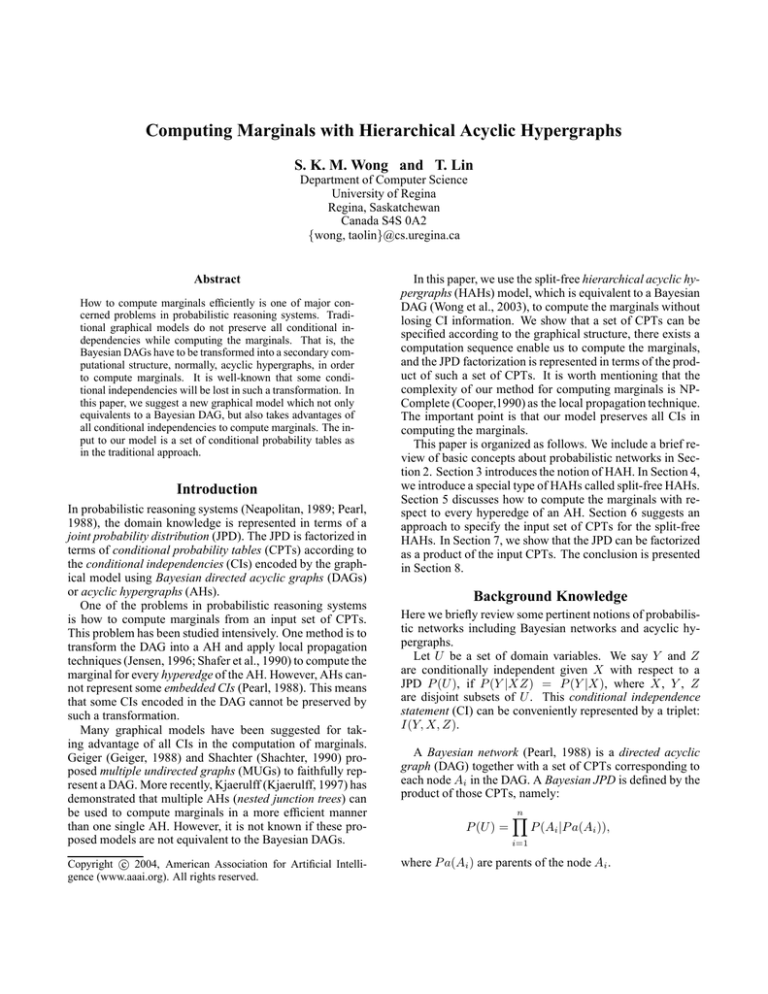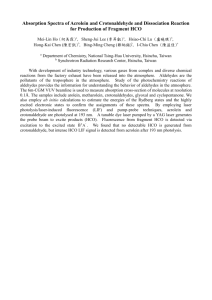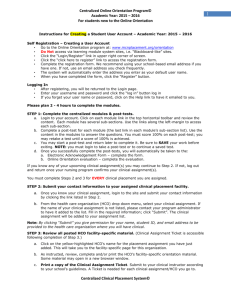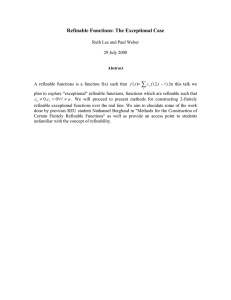
Computing Marginals with Hierarchical Acyclic Hypergraphs
S. K. M. Wong and T. Lin
Department of Computer Science
University of Regina
Regina, Saskatchewan
Canada S4S 0A2
{wong, taolin}@cs.uregina.ca
Abstract
How to compute marginals efficiently is one of major concerned problems in probabilistic reasoning systems. Traditional graphical models do not preserve all conditional independencies while computing the marginals. That is, the
Bayesian DAGs have to be transformed into a secondary computational structure, normally, acyclic hypergraphs, in order
to compute marginals. It is well-known that some conditional independencies will be lost in such a transformation. In
this paper, we suggest a new graphical model which not only
equivalents to a Bayesian DAG, but also takes advantages of
all conditional independencies to compute marginals. The input to our model is a set of conditional probability tables as
in the traditional approach.
Introduction
In probabilistic reasoning systems (Neapolitan, 1989; Pearl,
1988), the domain knowledge is represented in terms of a
joint probability distribution (JPD). The JPD is factorized in
terms of conditional probability tables (CPTs) according to
the conditional independencies (CIs) encoded by the graphical model using Bayesian directed acyclic graphs (DAGs)
or acyclic hypergraphs (AHs).
One of the problems in probabilistic reasoning systems
is how to compute marginals from an input set of CPTs.
This problem has been studied intensively. One method is to
transform the DAG into a AH and apply local propagation
techniques (Jensen, 1996; Shafer et al., 1990) to compute the
marginal for every hyperedge of the AH. However, AHs cannot represent some embedded CIs (Pearl, 1988). This means
that some CIs encoded in the DAG cannot be preserved by
such a transformation.
Many graphical models have been suggested for taking advantage of all CIs in the computation of marginals.
Geiger (Geiger, 1988) and Shachter (Shachter, 1990) proposed multiple undirected graphs (MUGs) to faithfully represent a DAG. More recently, Kjaerulff (Kjaerulff, 1997) has
demonstrated that multiple AHs (nested junction trees) can
be used to compute marginals in a more efficient manner
than one single AH. However, it is not known if these proposed models are not equivalent to the Bayesian DAGs.
c 2004, American Association for Artificial IntelliCopyright gence (www.aaai.org). All rights reserved.
In this paper, we use the split-free hierarchical acyclic hypergraphs (HAHs) model, which is equivalent to a Bayesian
DAG (Wong et al., 2003), to compute the marginals without
losing CI information. We show that a set of CPTs can be
specified according to the graphical structure, there exists a
computation sequence enable us to compute the marginals,
and the JPD factorization is represented in terms of the product of such a set of CPTs. It is worth mentioning that the
complexity of our method for computing marginals is NPComplete (Cooper,1990) as the local propagation technique.
The important point is that our model preserves all CIs in
computing the marginals.
This paper is organized as follows. We include a brief review of basic concepts about probabilistic networks in Section 2. Section 3 introduces the notion of HAH. In Section 4,
we introduce a special type of HAHs called split-free HAHs.
Section 5 discusses how to compute the marginals with respect to every hyperedge of an AH. Section 6 suggests an
approach to specify the input set of CPTs for the split-free
HAHs. In Section 7, we show that the JPD can be factorized
as a product of the input CPTs. The conclusion is presented
in Section 8.
Background Knowledge
Here we briefly review some pertinent notions of probabilistic networks including Bayesian networks and acyclic hypergraphs.
Let U be a set of domain variables. We say Y and Z
are conditionally independent given X with respect to a
JPD P (U ), if P (Y |XZ) = P (Y |X), where X, Y , Z
are disjoint subsets of U . This conditional independence
statement (CI) can be conveniently represented by a triplet:
I(Y, X, Z).
A Bayesian network (Pearl, 1988) is a directed acyclic
graph (DAG) together with a set of CPTs corresponding to
each node Ai in the DAG. A Bayesian JPD is defined by the
product of those CPTs, namely:
P (U ) =
n
Y
P (Ai |P a(Ai )),
i=1
where P a(Ai ) are parents of the node Ai .
A hypergraph hH, U i denotes a family of subsets of U ,
namely:
h H, U i = {h1 , h2 , . . . , hn },
where hi ⊆ U is called a hyperedge of hH, U i, and U is the
union of all hyperedges, written U = h1 h2 · · · hn . We use
H to denote the hypergraph hH, U i if no confusion arises.
We say U is the context of H, written CT (H) = U .
A hypergraph H is acyclic if there exists a hypertree construction ordering (h1 , h2 , . . . , hn ) such that
si = hi ∩ (h1 · · · hi−1 ) ⊆ hj , 1 ≤ j ≤ i − 1,
for 2 ≤ i ≤ n, where si is called the separator of hi . It
is worth mentioning that given an acyclic hypergraph, there
exists many hypertree construction orderings. In fact, for
each hyperedge of an acyclic hypergraph, there is a construction ordering beginning with that hyperedge (Shafer et al.,
1990). In the following discussion, we always assume the
subscripts of the hyperedges specify a hypertree construction ordering for the given AH.
The factorization of the JPD according to the AH is the
product of the CPT specified to each hyperedges. Thus,
Y
P (U ) =
P (ri |si ),
(1)
where ri = hi − si , 1 ≤ i ≤ n. Let S = {s2 , s3 , . . . , sn } =
{si |2 ≤ i ≤ n}, which is referred to as the set of separators of H. It should be noted that all hypertree construction
orderings have the same set of separators.
In an AH, We refer to P (hi ) as the marginal with respect
to the hyperedge hi . We say the hyperedge hi of an AH
computable if the marginal P (hi ) can be computed. The AH
is computable if marginals with respect to all hyperedges are
computable.
Hierarchical Acyclic Hypergraphs
In this section, we define the special graphical structure
called the hierarchical set of acyclic hypergraph (HAH). It
consists of a set of acyclic hypergraphs whose contexts form
a tree hierarchy.
We first define a tree hierarchy of hypergraphs. Let H
denotes a family of hypergraphs, written
H = { H 0 , H1 , . . . , H n } .
(2)
We call Hj a descendant of Hi , if CT (Hj ) ⊆ CT (Hi ),
0 ≤ i, j ≤ n. A hypergraph Hj is a child of Hi , if Hj is
a descendant of Hi and there is no hypergraph Hk in H
such that CT (Hj ) ⊆ CT (Hk ) ⊆ CT (Hi ). If Hj is a child
of Hi , we say Hi is a parent of Hj . If the AHs have no
parents, we say they are roots. We refer to the AHs without
children as the leafs.
Definition 1 A family of hypergraph H is called tree
hierarchy, if:
(1) There exists a root H0 such that for every hypergraph
Hj in H, CT (Hj ) ⊂ CT (H0 ), 1 ≤ j ≤ n.
(2) Assume Hj is the child of Hi , Then there exists a
hyperedge h of Hi such that CT (Hj ) ⊆ h.
(3) For two distinct children, written H1 and H2 , of Hi
such that CT (H1 ) ⊆ hj , CT (H2 ) ⊆ hk , where hj
and hk are two hyperedges of Hi , j is not equal to
k, i.e., j 6= k.
Let Hp be the parent of Hc in the tree hierarchy H. The
hyperedge h in Hp is refinable, if CT (Hc ) ⊆ h. We say Hc
is the child of h. A hyperedge without any child is called
non-refinable.
Now we use the concept of tree hierarchy to define the
hierarchical set of acyclic hypergraphs (HAH). We call H
the hierarchical set of AHs if all hypergraphs in the tree
hierarchy H are acyclic.
Example 1 Consider a given HAH H, written
H = {H1 , H2 , H3 , H4 },
where
H1
H2
H3
H4
= {BCDEF GH, AC, HK, GHI},
= {BG, BDE, DEF, CF H},
= {C, F },
= {BD, BE}.
The acyclic hypergraph H1 is the root of H, which has
one child H2 . The acyclic hypergraphs H3 and H4 are the
children of H2 and the decedents of H1 .
The split-free HAHs
In this section, we introduce the definition of split-free
HAHs. We use a special hyperedges ordering, denoted by
the hierarchy construction ordering (HCO), to test if the
given HAHsH is split-free. That is, if there is a HCO in
H, the we say H is a split-free HAHs. In the following
discussion, we use the notation hi ≺ hj to denote hi
appearing previous to hj in an hyperedges ordering.
Definition 2 A HAH H is called the split-free HAH if there
exists a special hyperedges ordering for all hyperedges of
H , written h1 ≺ h2 ≺, . . . , ≺ hn , such that,
(1) In the ordering, the appearing sequence of the
hyperedges that comes from the same AH H is the
hypertree construction ordering of H;
(2) If hi is the refinable hyperedge such that
CT (Hc ) ⊆ hi , then hk ≺ hi , for every hyperedge
hk ∈ H c ;
(3) If hi is the refinable hyperedge such that
CT (Hc ) ⊆ hi . then for the separator si of hi ,
si ⊆ hj , where hj is the first hyperedges of Hc
appearing in the ordering.
We refer to such an ordering as the hierarchy construction
ordering (HCO) of H.
Example 2 Consider the HAH H shown in Figure 2(a).
There exists a HCO such that,
AD ≺ AB ≺ AC ≺ ABC ≺ BCE,
where we use underlines to highlights refinable hyperedges
of H.
The hypertree construction ordering of the AHs H1
and H2 in the sequence are: AD ≺ ABC ≺ BCE and
AB ≺ AC. It can be verified that they are the hypertree
construction orderings of H1 and H2 , respectively. For
the refinable hyperedge ABC such that CT (H2 ) ⊆ ABC,
B
B
D
G
D
A
C
C
F
E
E
F
H
H2
H
G
K
C
F
I
B
D
H1
H3
E
H4
Figure 1: The hierarchical acyclic hypergraph given in Example 1.
B
B
D
A
C
D
E
A
E
C
H3
H1
B
B
B
A
E
A
C
C
H2
(a)
C
H4
H5
(b)
Figure 2: Two types of HAHs. The HAH shown at Part (a)
is a split-free HAH. Part (b) is not a split-free HAH.
the condition AB ≺ ABC and AC ≺ ABC hold in the
ordering. Consider the separator A of refinable hyperedge
ABC. It satisfies A ⊆ AB, where AB is the first hyperedge
of H2 appearing in the ordering.
Note that a split-free HAH may have many HCOs. For
instance, another HCO for the HAH shown at Figure 2(a) is:
AD ≺ AC ≺ AB ≺ ABC ≺ BCE.
Note that not all HAHs have the HCOs. There exists no
HCO for the HAH shown at Figure 2(b).
Consider a HCO of the split-free HAH. The following
proposition states that the intersection of a hyperedge hi
with the union of the previous hyperedges in the ordering
is contained by one of hyperedge hj such that hj ≺ hi .
Proposition 1 Consider a HCO for the split-free HAH,
written h1 ≺ h2 ≺ · · · ≺ hn . Then hi ∩ (h1 · · · hi−1 ) ⊆ hj ,
where hj ≺ hi in the HCO.
Proof. By induction. Consider the hyperedges of the root,
by definition of HCO, it is obvious for the hyperedges of the
root.
Assume hi is a refinable hyperedge of the root and Hc is
the child such that CT (Hc ) ⊆ hi . By definition of HCO, all
hyperedges of Hc appears previous to hi . It means that the
union of them is still hi . Hence, the intersection of CT (Hc )
and all previous hyperedges is still the separator of hi . By
definition of HCO, the separator is contained by the first
hyperedge hj of Hc and hj ≺ hi . The argument above
can be applied recursively for all hyperedges in the given
split-free HAH.
Note that Proposition 1 enables us to search a HCO for
the given HAH. Consider two hyperedges hi and hj of an
acyclic hypergraph H in the HAH H, where hi is a refinable
hyperedge, and hi ∩ hj = s. If s is split by the decedents
of hi , by definition of HCO, then the condition hi ≺ hj
should hold in any HCO of H. Since hi and hj are in the
same hypergraph H, it follows that an available hypertree
construction orderings of H for a HCO of H has to satisfy
hi ≺ hj . This restricts our choice to select the hyperedges
ordering of H: when we choose a hypertree construction
ordering of H, we have to check if hi ≺ hj . If not, we
have to select another hypertree construction ordering which
satisfies the condition. If we cannot find any construction
ordering satisfying the condition, then there is no HCO for
H.
Example 3 Consider two HAHs shown in Figure 2 (a)
and (b). Now we show how to determine if they have HCOs
respectively.
Consider hyperedges ABC and BCE in AH H1 . In
the child H2 of refinable hyperedge ABC, since AB and
BC split BC = ABC ∩ BCE, by definition of HCO, it
means that BC cannot be the separator of BCE. Therefore, ABC ≺ BCE should hold in any HCO. At the same
time, there are four hypertree construction orderings of H1 ,
namely,
AD ≺ ABC ≺ BCE,
BCE ≺ ABC ≺ AD,
ABC ≺ BCE ≺ AD,
ABC ≺ AD ≺ BCE.
It can be found that only the first and the last hypertree construction orderings satisfy the condition ABC ≺ BCE. After we add hyperedges of H2 in the ordering, we obtain the
HCO for the HAH in Figure 2 (a). Therefore, it is a split-free
HAH.
Applying the same method to the HAH in Figure 2 (b),
we have two conditions to satisfy, namely, ABC ≺ BCE
and BCE ≺ ABC. Since none of the ordering would satisfy these two conditions, there is no HCO for the HAH.
Therefore, it is not a split-free HAH.
The computability of AH
In this section, we show how to compute marginals with
respect to every hyperedge in an AH H by explicitly
assigning CPTs to the hyperedges of H.
The following proposition states that an AH H is computable if we can provide the marginal with respect to the
first hyperedge in a hypertree construction ordering of H .
Proposition 2 Consider an AH H = {h1 , h2 , . . . , hn },
where subscripts specify the hypertree construction ordering of H. If P (h1 ) can be computed, then for any hyperedge
hi , 2 ≤ i ≤ n, P (hi ) can be computed by specifying CPT
P (ri |si ) to the hyperedge hi .
Proof. By induction. Suppose P (h1 ) is computed, by specifying the CPT P (r2 |s2 ) to the hyperedge h2 , then we can
compute P (h2 ) as:
X
P (h2 ) = P (s1 )P (r2 |s2 ) =
P (h1 ) P (r2 |s2 ).
r1
In general, when we specify the CPT P (ri |si ) to every hyperedge hi , i ≤ 2, the marginal with respect to the hyperedge hi can be computed as:
X
P (hi ) = P (si )P (ri |si ) =
P (hj ) P (ri |si ),
rj
where si ⊆ hj , 1 ≤ j ≤ i − 1. It means that P (hi ) can be
computed if P (hj ) is computed, where j < i. Therefore,
following a given hypertree construction ordering of the
acyclic hypergraph H, we always can compute the marginal
with respect to every hyperedge hi in H, by specifying CPTs
P (ri |si ) to the hyperedge hi .
h’3
h’2
A
B
E
G
ABC ≺ BCD ≺ DEF ≺ EF G ≺ F H.
If P (h1 ) = P (ABC) is computed, then we can specify P (D|BC), P (EF |D), P (G|EF ) and P (H|F ) to the
hyperedge BCD, DEF , EF G and F H separately, so as
to compute marginals P (BCD), P (DEF ), P (EF G) and
P (F H) consecutively.
It can be verified that the factorization of JPD P (U ) according to H is the product of specified CPTs, namely:
P (U ) = P (ABC)P (D|BC)P (EF |D)P (G|EF )P (H|F ).
Since an acyclic hypergraph may have a hypertree construction odering beginning with any hyperedge (Shafer et
al., 1990), by Proposition 2, it follows that an AH is computable if we can compute the marginal with respect one of
hyperedges of H.
Marginals computation in split-free HAHs
In this section, we show that a set of CPTs can be specified
according to the HCO of the given split-free HAH H in
order to compute marginals with respect to hyperedges of
H. We refer to a HAH as computable if marginals with
respect to all hyperedges are computable.
Consider a HAH H. If one of the refinable hyperedges
h equals to the context of its own child Hc , namely, h =
CT (Hc ), as soon as its child is computable, this refinable
hyperedge h is computable as well. Then we only need
to specify P (h) = 1 to this refinable hyperedge. Sometimes the refinable hyperedge properly contains the context
of its child, thus, (Hc ) ⊂ h, then we always can specify
the CPT P (r|CT (Hc )) to the refinable hyperedge, where
r = h − CT (Hc ). For instance, in Example 1, the refinable hyperedge CF H of H2 properly contains the context
of its child H3 = {C, F }. We only need to specify CPT
P (H|CF ) to this refinable hyperedge, if the marginal with
respect to the child, namely P (CF ), is computable. In the
following discussion, we will only consider how to specify
CPTs to the non-refinable hyperedges.
The following theorem enables us to specify a set of CPTs
for the given split-free HAH H such that the marginals with
respect to every hyperedges of H can be computed.
Theorem 1 A HAH H is computable if and only if it is splitfree.
C
D
h’4
A hypertree construction ordering of H is:
h’1
F
h’5
H
Figure 3: The hypergraph given in the Example 4.
Example 4 Consider the hypergraph as shown in Figure 3,
namely:
H = {ABC, BCD, DEF, EF G, F H}.
Proof. Assume there exists a HCO for H, namely, h1 ≺
h2 ≺, . . . , ≺ hn . By Proposition 1, Let si = hi ∩
(h1 · · · hi−1 ) ⊆ hj , where hi ≺ hj in the HCO. If the
first hyperedge h1 is computable, by specifying the CPTs
p(ri |si ) to the remaining hyperedges of the HCO, where
ri = hi − si , then all hyperedges of the given HAH can
be computed.
Suppose there exists no HCO for the HAH H. It means
that there exists an AH H in the HAH H such that, no
matter how we specify the hypertree construction ordering
of H, there always exists at least one refinable hyperedge
of H, namely CT (Hc ) ⊆ hi , such that the separator si of
hi is located in two different hyperedges of Hc , namely
h0j and h0k . By Proposition 1, we only can get P (si ) from
the previous marginal computations, and there is no way to
compute P (h0j ) and P (h0k ) consistently. It means that Hc
cannot be computed.
By Theorem 1, given a HCO with respect to the split-free
HAH, written h1 ≺ h2 ≺ . . . ≺ hn , we can specify the CPT
P (ri |si ) to every non-refinable hyperedge hi , where si =
hi ∩(h1 · · · hi−1 ), ri = hi −si . If P (hj ) is computable, then
we may compute the marginal with respect to the hyperedge
hi , such that, P (hi ) = P (ri |si )P (si ). It means that if h1
in the HCO is computable, then all other hyperedges will be
computed subsequently.
Example 5 Consider a HAH shown at Figure 2(a), written
where P (ri |si ), 1 ≤ i ≤ n, is the CPT specified to each
hyperedges hi of H.
Proof. Consider the root of the HAH H, written Hroot =
{h1 , h2 , . . . , hn }. The subscripts specify the hypertree construction ordering, which is the same as showing in the given
HCO of H. The JPD P (U ) can be factorized according to
the root as follows:
P (U ) =
n
Y
P (ri |si ),
where si is the separator of hi , ri = hi − si , 1 ≤ i ≤ n.
Assume hk is a refinable hyperedge such that CT (Hk ) ⊆
hk , where Hk = {h01 , h02 , . . . , h0m }. It follows that:
H1 = {H1 , H2 },
where
P (hk ) = P (rk |CT (Hk ))
H1 = {AD, ABC, BCE},
H2 = {AB, AC}.
AB ≺ AC ≺ ABC ≺ AD ≺ BCE.
According to the given HCO, after providing the marginal
P (AB) to the hyperedge AB, the marginal with respect to
the hyperedge AC can be computed by specifying the CPT
P (C|A) to the hyperedge AC. It means that the refinable
hyperedge ABC is computed. By specifying P (D|A)
and P (E|BC) to the hyperedges AD and BCE of H1 ,
respectively, these two hyperedges can be computed as well.
By definition, it means that H1 is a computable HAH.
Consider a HAH shown at Figure 2(b), namely:
H2 = {H3 , H4 , H5 },
H3 = {AD, ABC, BCE},
H4 = {AB, AC},
H5 = {BE, CE}.
Although we may provide any marginals to the hyperedges AD, AB or AC, respectively, we can not compute
the marginals P (BE) and P (BC) at the same time. On
the other hand, suppose we have the marginals P (BE) and
P (BC) computed, the hyperedges AB and AC can not be
computed simultaneously. Therefore, the HAH H2 is not
computable.
where
The JPD factorization according to the
split-free HAH
In previous section, we show that the HCO in the split-free
HAH H enables us to assign a set of CPTs in order to compute marginals with respect to hyperedges of H. In this section, moreover, we will show that the JPD can be factorized
in terms of the product of such a set of CPTs.
Proposition 3 Consider a HCO of the split-free HAH H,
written h1 ≺ h2 ≺ · · · ≺ hn . The factorization of JPD
P (U ) according to H can be represented as follows:
n
Y
i=1
m
Y
P (rj0 |s0j ),
j=1
There is a HCO of H1 , written
P (U ) =
(4)
i=1
where rk = hk − CT (Hk ), rj = h0j − s0j , 1 ≤ j ≤ m.
Hence,
Q
0 0
P (rk |CT (Hk )) m
P (hk )
j=1 P (rj |sj )
P (rk |sk ) =
=
.
P (sk )
P (sk )
By definition of HCO, sk ⊆ h01 . It follows that:
P (rk |sk ) = P (rk |CT (Hk ))P (r10 |sk )
m
Y
P (rj0 |s0j ),
(5)
j=2
where r10 = h01 − sk .
Substitute Equation (5) into Equation (4), it follows that
P (U )
=
n
Y
i6=k
P (ri |si ) P (rk |CT (Hk ))
P (r10 |sk )
m
Y
P (rj0 |s0j ).
(6)
j=2
The argument above thereafter can be applied recursively
until all hypergraphs are considered for the HAH H, which
results in the factorization of JPD P (U ), as shown in Equation (3).
Example 6 Consider the split-free HAH H given in Example 1. According to the HCO given in Equation (??), the
CPTs specified to the corresponding hyperedges are listed
as follows:
(
)
P (BG), P (D|B), P (E|B), 1,
P (F |DE), P (C), 1, P (H|CF ), 1,
.
(7)
P (A|C), P (K|H), P (I|GH)
In the HCO, the hypertree construction ordering for the
root H1 is
BCDEF GH ≺ AC ≺ HK ≺ GHI.
The JPD P (U ) can be factorized as follows:
P (ri |si ).
(3)
P (U ) = P (BCDEF GH)P (A|C)P (K|H)P (I|GH). (8)
Consider the refinable hyperedge BDEF GH, where
CT (H2 ) ⊆ BDEF GH. The hypertree construction ordering of H2 in the HCO is:
BG ≺ BDE ≺ DEF ≺ CF H.
The marginal P (BCDEF GH) can be factorized as follows:
P (BCDEF GH)
= P (BG)P (DE|B)
P (F |DE)P (CH|F ).
(9)
Consider the refinable hyperedge BDE of H2 , where
CT (H3 ) ⊆ BDE. Since the first hyperedge of H3 appearing in the HCO is BD, which contains the separator B of
BDE. It follows that the CPT specified to BDE, namely,
P (DE|B), can be rewritten
P (DE|B)
P (BD)P (E|B)
P (DEB)
=
P (B)
P (B)
= P (D|B)P (E|B).
(10)
=
Substituting Equation (10) into Equation (9), it yields:
P (BCDEF GH)
= P (BG)P (D|B)P (E|B)
P (F |DE)P (CH|F ). (11)
Substituting Equation (11) into Equation (8), it yields:
P (U ) = P (BG)P (D|B)P (E|B)P (F |DE)P (CH|F )
P (I|GH)P (A|C)P (K|H).
The approach can be applied recursively until all AHs are
considered. In the end, the CPTs in Equation (7) are specified to all hyperedges of H. The factorization of JPD according to the HAH H thereafter can be represented by:
P (U ) = P (BG)P (D|B)P (E|B)P (F |DE)P (C)
P (H|CF )P (A|C)P (K|H)P (I|GH).
Conclusion
In this paper, we suggest a graphical model called the splitfree HAH, which not only is equivalent to a Bayesian DAG,
but also enables us to compute the marginals without losing
any CI information. Similar to the conventional probabilistic network, we can specify an input set of CPTs according
to the graphical structure. The JPD can be factorized as a
product of such a set of CPTs.
Acknowledgement
The authors would like to thank anonymous referees for
their useful suggestions and critical comments.
References
Beeri, C., Fagin, R., Maier, D., and Yannakakis, M.: On
the desirability of acyclic database schemes. J. ACM vol.
30, No. 3, July 1983, pp479-513.
Gregory F. Cooper: The Computational Complexity of
Probabilistic Inference Using Bayesian Belief Networks.
Artificial Intelligence, Vol. 42, No.2-3, 1990, pp393-405.
D. Geiger: Towards the formalization of informational dependencies. Technical Report CSD-880053, University of
California at Los Angeles, 1988.
Heckerman, D., Geiger, D. and Chickering, D.M.: Learning Bayesian networks:the combination of knowledge and
statistical data. Machine Learning, 20:197-243, 1995.
Jensen, F.V.: An introduction to Bayesian networks. UCL
Press, 1996.
U. Kjaerulff: Nested junction trees. In Thirteenth Conference on Uncertainty in Artificial Intelligence, pp 302-313.
Providence, Rhode Island, 1997.
R. E. Neapolitan: Probabilistic Reasoning in Expert Systems. John Wiley & Sons, Inc. 1989
J. Pearl: Probabilistic Reasoning in Intelligent Systems:
Networks of Plausible Inference. Morgan Kaufmann Publishers, San Francisco, 1988.
R.D. Shachter: A graph-based inference method for conditional independence. In Seventh Conference on Uncertainty in Artificial Intelligence, pp 353-360, Morgan Kaufmann Publishers, 1990.
G. R. Shafer, P. P. Shenoy: Probability Propagation, Annals
of Mathematics and Artificial Intelligence, Vol.2, pp. 327352, 1990
Wilhelm Rödder, Carl-Heinz Meyer: Coherent Knowledge
Processing at Maximum Entropy by SPIRIT, In Twelfth
Conference on Uncertainty in Artificial Intelligence, pp
470-476, Morgan Kaufmann Publishers, 1996.
S.K.M. Wong, T. Lin: An alternative characterization of a
Bayesian Network, International Journal of Approximate
Reasoning, Vol.33, No.3, pp221-234, 2003




